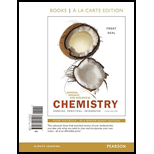
a.
To determine:
The attractive forces in the given compound.
Introduction:
Attractive forces represent the intermolecular forces present between molecules. Attractive forces are caused by the attraction of an electron-rich area of one compound to electron poor area of another compound... There are mainly five types of attractive forces: London forces, hydrogen bonding, dipole-dipole attraction, ion-dipole attraction, and ionic attraction.
b.
To determine:
The types of attractive forces in the given compound.
Introduction:
Attractive forces represent the intermolecular forces present between molecules. Attractive forces are caused by the attraction of an electron-rich area of one compound to electron poor area of another compound... There are mainly five types of attractive forces: London forces, hydrogen bonding, dipole-dipole attraction, ion-dipole attraction, and ionic attraction.
c.
To determine:
The types of attractive forces in the given compound.
Introduction:
Attractive forces represent the intermolecular forces present between molecules. Attractive forces are caused by the attraction of an electron-rich area of one compound to electron poor area of another compound... There are mainly five types of attractive forces: London forces, hydrogen bonding, dipole-dipole attraction, ion-dipole attraction, and ionic attraction.
d.
To determine:
The types of attractive forces in the given compound.
Introduction:
Attractive forces represent the intermolecular forces present between molecules. Attractive forces are caused by the attraction of an electron-rich area of one compound to electron poor area of another compound... There are mainly five types of attractive forces: London forces, hydrogen bonding, dipole-dipole attraction, ion-dipole attraction, and ionic attraction.
e.
To determine:
The types of attractive forces in the given compound.
Introduction:
Attractive forces represent the intermolecular forces present between molecules. Attractive forces are caused by the attraction of an electron-rich area of one compound to electron poor area of another compound... There are mainly five types of attractive forces: London forces, hydrogen bonding, dipole-dipole attraction, ion-dipole attraction, and ionic attraction.
f.
To determine:
The types of attractive forces in the given compound.
Introduction:
Attractive forces represent the intermolecular forces present between molecules. Attractive forces are caused by the attraction of an electron-rich area of one compound to electron poor area of another compound... There are mainly five types of attractive forces: London forces, hydrogen bonding, dipole-dipole attraction, ion-dipole attraction, and ionic attraction.
Want to see the full answer?
Check out a sample textbook solution
Chapter 7 Solutions
General, Organic, and Biological Chemistry, Books a la Carte Edition (3rd Edition)
- When a doughnut is placed on a napkin, the napkin will often absorb a liquid and appear moist. What is most likely the nature of the liquid?arrow_forwardSubstance A is composed of molecules that have stronger intermolecular forces than the molecules that compose substance B. Which substance has a lower boiling point? a. substance A b. substance B c. cannot be determined without more information.arrow_forwardWhich compound has the strongest intermolecular forces? (a) H2O (b)H2S (c)H2Se (d) H2Tearrow_forward
- Rank the compounds in Figure 27 from highest to lowest boiling point. * D > C > B > A C > D > A > B D > B > C > A C > A > B > D None of these rankings is correct.arrow_forwardConsidering intermolecular forces in the pure substance, which of these substances exists as a gas at 25°C and 1atm? a. CH3CH2CH2CH3 (butane) b. CH3OH (methanol) c. Ararrow_forward(van’t hoff) use van’t hoff to calculate freezing and boiling points; don’t know what went wrongarrow_forward
- The critical temperature of methane is -82°C. This means that methane ; a) can never be a liquid at -95°C b) boils at -82°C c) contains strong hydrogen bonds d) can never be a liquid at room temperature pick the best answer choicearrow_forwardHow much heat is given up when 20g of steam at 100°C is condensed and cooled to 20°C? A. 1.6 kcal B. 21.6 kcal C. 10.8 kcal D. 12.4 kcalarrow_forwardFood Science: Colligative Property of Ice cream in a bag GUIDE QUESTIONS: 1. What will happen if salts will not be added to ice cubes? 2. What happens if different kind of salt was added to the ice cubes? 3. Why do you think the ice cream in the bag works?arrow_forward
- Which of the following has only London dispersion forces as the primary attraction between molecules? Which of the following has only London dispersion forces as the primary attraction between molecules? A. H2S B. CH3CH2OH C. CH3OH D. CH3CH3arrow_forwardWhich is most viscous at the same temperature? a. hexanoic acid b. hexanol c. pentanolarrow_forwardWhat intermolecular force/s of attraction is not involved in producing a biodegradable plastic bag (polyethylene and polyvinyl alcohol)? A. London Dispersion Forces B. Dipole - dipole C. Hydrogen Bond D. Ionic Bondarrow_forward
 Introductory Chemistry: A FoundationChemistryISBN:9781337399425Author:Steven S. Zumdahl, Donald J. DeCostePublisher:Cengage Learning
Introductory Chemistry: A FoundationChemistryISBN:9781337399425Author:Steven S. Zumdahl, Donald J. DeCostePublisher:Cengage Learning
 Chemistry for Today: General, Organic, and Bioche...ChemistryISBN:9781305960060Author:Spencer L. Seager, Michael R. Slabaugh, Maren S. HansenPublisher:Cengage Learning
Chemistry for Today: General, Organic, and Bioche...ChemistryISBN:9781305960060Author:Spencer L. Seager, Michael R. Slabaugh, Maren S. HansenPublisher:Cengage Learning



